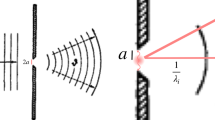Summary
It is shown how it is possible, by means of geometry and the introduction of a principle of measurement, founded by analogy with the theory of H. Weyl, to discover a unity existing between gravitational, electromagnetic and quantum phenomena. Dirac’s equation and an extension of it are derived from the principle of measurement, and an essential feature of the theory is that it incorporates a theory of the electron in which its mass appears as a geometrical quantity, entering into the equation as a consequence of the existence of a fundamental unit of length. The observed mass is given by this geometrical mass together with interaction terms which also enter naturally into the theory.
Riassunto
Si dimostra come sia possibile, per mezzo della geometria e dell’introduzione di un principio di misura basato, per analogia, sulla teoria di H. Weyl di scoprire un’unitarietà esistente tra i fenomeni gravitazionali, elettromagnetici e quantistici. L’equazione di Dirao e una sua estensione si derivano dal prinoipio di misura e un aspetto essenziale della teoria è di incorporare una teoria dell’elettrone nella quale la massa di questo appare come una grandezza geometrica che entra nell’equazione come conseguenza dell’esistenza di un’unità fondamentale di lunghezza. La massa osservata è data da questa grandezza geometrica assieme a termini d’interazione che a loro volta entrano naturalmente nella teoria.
Similar content being viewed by others
References
H. Weyl:Baum, Zeit, Materie (Berlin, 1921), p. 110.
Th. Kaluza:Sitzgsber. preuss. Akad. Wiss. (1921), p. 966.
H. T. Flint:Proe. Phys. Soc,29, 334 (1940);
J. W. Fishee:Proc. Boy. Soc, A123, 489 (1929);H. T. Flint andE. M. Williamson:Nuovo Cimento,3,4 (1956).
A. S. Eddington:Math. Theory of Relativity, 2nd Edition (Cambridge 1930), P.191.
H. T. Flint andE. M. Williamson:Nuovo Cimento,3,4 (1956).
H. T. Flint:Proc. Phys. Soc,29, 417 (1940).
H. T. Flint:Proc. Roy. Soc, A870, 150, 432 (1935);H. T. Flint andE. M. Williamson:Zeits. f. Phys.,135, 260 (1953).
H. A. Bethe andS. Salpeter:Handb. d. Phys.,35-I, 178 (1954).
Author information
Authors and Affiliations
Rights and permissions
About this article
Cite this article
Flint, H.T., Williamson, E.M. The theory of relativity, the electromagnetic theory and the quantum theory. Nuovo Cim 8, 680–698 (1958). https://doi.org/10.1007/BF02815248
Received:
Published:
Issue Date:
DOI: https://doi.org/10.1007/BF02815248




